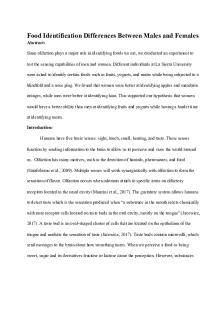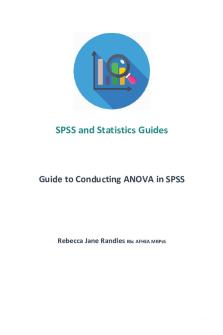Lesson 11 - Testing for Differences and Normality in SPSS PDF

| Title | Lesson 11 - Testing for Differences and Normality in SPSS |
|---|---|
| Author | Lauren Dowdeswell |
| Course | Scientific Data and Analysis |
| Institution | University of Chester |
| Pages | 7 |
| File Size | 343.8 KB |
| File Type | |
| Total Downloads | 62 |
| Total Views | 145 |
Summary
This is how to test for differences and normality in SPSS...
Description
Testing for Differences and Normality in SPSS - RC4111 Learning Objectives:
Recap - what tests for differences allows us to do
Different types of tests
How to use normality in SPSS
Parametric tests in SPSS - T test and Paired T test
Non-parametric tests in SPSS - Mann Whitney and Wilcoxon
Testing for Differences Recap:
Tests for differences investigate effects of one or more IV’s (with two or more levels) on a numerical (usually continuous) DV
The nature of the levels of the IV determine which tests to use (independent/related samples)
Independent and Related Samples:
Samples - IV levels (groups)
Test for Differences (2 Groups):
Independent samples o
Independent samples t-test
o
Mann Whitney U test
Non-parametric
Paired samples o
Paired samples t-test
o
Parametric
Wilcoxon signed-rank test
Parametric
Non-parametric
H0 - there is no difference between the measurements for the different groups
Outlook of Parametric Tests:
Independent test o
Parametric - data needs to be normally distributed
o
Compares means of the group
o
Uses standard error of the mean (SE)
o
Independent samples
Paired T test o
Very similar to the independent samples t-test
o
Compares mean responses/measurements
o
Two related groups using standard error of the mean
o
Paired samples
Outlook for Non-Parametric Tests:
Mann Whitney U o
Non-parametric data can be different from normal
o
Compares medians of the group
o
Uses ranks
o
Independent samples
Wilcoxon signed rank test o
Similar to Mann Whitney U test for independent samples
o
Compares median responses of two related groups]
o
Uses ranks (similar to interquartile range)
o
Paired samples
How do we decide on a statistical test? 1. Identify the dependent and dependent variable 2. What kind of data are these? 3. If applicable: is my data independent or paired?
4. If applicable: is my data normally distributed? Normality - how is my data distributed?
To determine if data is normal or not, we look at histograms and perform tests for normality
2 common tests - Shapiro-Wilk and Kolmogorov-Smirnov
H0 - there is no difference between the distribution of the observed data and a normal distribution (the data is normally distributed)
Important - we want the null hypothesis to be true in order for our data to be normal (parametric)
Normality Tests - Generate P Values:
P-Value >/= 0.05 accept H0; data is not different from normal
P-Value < 0.05 reject H0; data is different from normal
Why do we need to know this? o
To determine the appropriate statistical approach (which test to use)
Normality in SPSS:
What does this mean - is the data normally distributed for both IV levels?
Only if all are normally distributed (p>0.05) can we use parametric statistics to test for differences/correlations etc. to answer our research questions
Normality in SPSS:
Analyse descriptive statistics explore
Then select the dependent and independent variable (factor list), then in the plots option, select ‘normality plots with tests’. Click continue, then okay.
Example Data 1 - Effect of reproduction on the foraging behaviour of ewes. Energetically, producing milk is the most demanding period of the reproductive process for mammalian females. But do ewes spend more time eating when they are lactating in order to compensate for this demand. Is there a difference in the time ewes spend grazing when they do and do not have lambs? This would be related samples as you are looking at the same ewes but with lambs and without lambs. Data in SPSS (paired samples)
Remember - each row is a case (ewe), each column is a variable (grazing time)
Example Data 2 - effect of sex on propensity to developing osteoporosis? According to literature, women are more susceptible than men; 1 in 3 over the age of 50 affected. But is this measurable before patients develop clinical signs of osteoporosis? Does sex affect bone density in healthy 50+ patients? This would be independent samples as the male’s results would not have an affect on the females results and vice versa.
Remember - each row is a case (patient), each column is a variable (sex and bone density)
Independent Samples in SPSS
Paired Samples in SPSS...
Similar Free PDFs

Lesson 11 - Apuntes 11
- 3 Pages

T-Test In SPSS
- 2 Pages

Gender differences in senses
- 11 Pages

Gender differences in crime
- 6 Pages

Dummy VAriable in SPSS
- 4 Pages

Personality-data-in-SPSS
- 6 Pages

ANOVA Analysis in SPSS
- 12 Pages
Popular Institutions
- Tinajero National High School - Annex
- Politeknik Caltex Riau
- Yokohama City University
- SGT University
- University of Al-Qadisiyah
- Divine Word College of Vigan
- Techniek College Rotterdam
- Universidade de Santiago
- Universiti Teknologi MARA Cawangan Johor Kampus Pasir Gudang
- Poltekkes Kemenkes Yogyakarta
- Baguio City National High School
- Colegio san marcos
- preparatoria uno
- Centro de Bachillerato Tecnológico Industrial y de Servicios No. 107
- Dalian Maritime University
- Quang Trung Secondary School
- Colegio Tecnológico en Informática
- Corporación Regional de Educación Superior
- Grupo CEDVA
- Dar Al Uloom University
- Centro de Estudios Preuniversitarios de la Universidad Nacional de Ingeniería
- 上智大学
- Aakash International School, Nuna Majara
- San Felipe Neri Catholic School
- Kang Chiao International School - New Taipei City
- Misamis Occidental National High School
- Institución Educativa Escuela Normal Juan Ladrilleros
- Kolehiyo ng Pantukan
- Batanes State College
- Instituto Continental
- Sekolah Menengah Kejuruan Kesehatan Kaltara (Tarakan)
- Colegio de La Inmaculada Concepcion - Cebu








